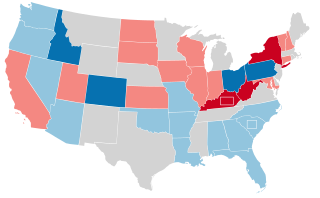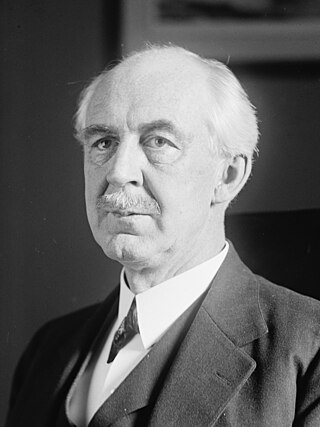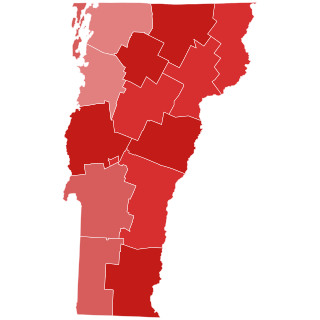
The 1986 United States Senate elections were elections for the United States Senate. Held on November 4, in the middle of Ronald Reagan's second presidential term, the 34 seats of Class 3 were contested in regular elections. The Republicans had to defend an unusually large number of freshman Senate incumbents who had been elected on President Ronald Reagan's coattails in 1980. Democrats won a net of eight seats, defeating seven freshman incumbents, picking up two Republican-held open seats, and regaining control of the Senate for the first time since January 1981. This remains the most recent midterm election cycle in which the sitting president's party suffered net losses while still flipping a Senate seat.

The 1974 United States Senate elections were held on November 4, with the 34 seats of Class 3 contested in regular elections. They occurred in the wake of the Watergate scandal, Richard M. Nixon's resignation from the presidency, and Gerald Ford's subsequent pardon of Nixon. Economic issues, specifically inflation and stagnation, were also a factor that contributed to Republican losses. As an immediate result of the November 1974 elections, Democrats made a net gain of three seats from the Republicans, as they defeated Republican incumbents in Colorado and Kentucky and picked up open seats in Florida and Vermont, while Republicans won the open seat in Nevada. Following the elections, at the beginning of the 94th U.S. Congress, the Democratic caucus controlled 60 seats, and the Republican caucus controlled 38 seats.

The 1968 United States Senate elections were elections for the United States Senate. Held on November 5, the 34 seats of Class 3 were contested in regular elections. They coincided with the presidential election of the same year. The Republicans picked up five net seats in the Senate. This saw Republicans win a Senate seat in Florida for the first time since Reconstruction.

The 1956 United States Senate elections were elections for the United States Senate that coincided with the re-election of President Dwight D. Eisenhower. The 32 seats of Class 3 were contested in regular elections, and three special elections were held to fill vacancies. Although Democrats gained two seats in regular elections, the Republicans gained two seats in special elections, leaving the party balance of the chamber unchanged.

Porter Hinman Dale was an American educator, lawyer, and politician who served as a member of both the United States House of Representatives from 1915 to 1923, and the United States Senate from Vermont from 1923 to 1933.

Ernest Willard Gibson was an American politician and lawyer from Vermont. A Republican, he served in both the United States House of Representatives (1923-1933) and United States Senate (1933-1940).

The Vermont Senate is the upper house of the Vermont General Assembly, the state legislature of the U.S. state of Vermont. The senate consists of 30 members elected from multi-member districts. Each senator represents at least 20,300 citizens. Senators are elected to two-year terms and there is no limit to the number of terms that a senator may serve.

Elections in Vermont are authorized under Chapter II of the Vermont State Constitution, articles 43–49, which establishes elections for the state level officers, cabinet, and legislature. Articles 50–53 establish the election of county-level officers.

The 1932 United States Senate election in Vermont took place on November 8, 1932. Republican Porter H. Dale successfully ran for re-election to another term in the United States Senate, defeating Democratic candidate Fred C. Martin. Dale died in October 1933, vacating the seat until a special election was held in January 1934.

The 1942 Vermont gubernatorial election took place on November 3, 1942. Incumbent Republican William H. Wills ran successfully for re-election to a second term as Governor of Vermont, defeating Democratic candidate Park H. Pollard.

The 1930 Vermont gubernatorial election took place on November 4, 1930. Incumbent Republican John E. Weeks did not run for re-election to a third term as Governor of Vermont. Republican candidate Stanley C. Wilson defeated Democratic candidate Park H. Pollard to succeed him.

The 1910 Vermont gubernatorial election took place on September 6, 1910. Incumbent Republican George H. Prouty, per the "Mountain Rule", did not run for re-election to a second term as Governor of Vermont. Republican candidate John A. Mead defeated Democratic candidate Charles D. Watson to succeed him.

The 1988 United States Senate election in Vermont took place on November 8, 1988. Incumbent Republican Robert Stafford did not run for re-election to another term in the United States Senate. Republican candidate Jim Jeffords defeated Democratic candidate Bill Gray to succeed him.

The 1926 United States Senate election in Vermont took place on November 2, 1926. Republican Porter H. Dale successfully ran for re-election to a full term in the United States Senate, defeating Democratic candidate James E. Kennedy.

The 1934 United States Senate special election in Vermont took place on January 16, 1934. Republican Ernest W. Gibson, Sr. was elected to the United States Senate to serve the remainder of the deceased Porter H. Dale's term, defeating Democratic candidate Harry W. Witters.

The 1974 United States Senate election in Vermont took place on November 5, 1974. The incumbent Republican Senator, George Aiken, did not run for re-election to another term in the United States Senate. The Democratic nominee, Patrick Leahy, the state's attorney of Chittenden County, defeated Republican nominee, Rep. Richard W. Mallary, to become Aiken's successor. This election also included Liberty Union Party candidate Bernie Sanders, who won 4.1% of the vote.

A general election was held in the U.S. state of Vermont on November 6, 2018. All of Vermont's executive officers were up for election as well as Vermont's Class I Senate seat and at-large seat in the United States House of Representatives. Primary elections were held on August 14, 2018.

The 2022 Vermont Senate election took place on November 8, 2022, as part of the biennial United States elections. The election coincided with elections for other offices including the U.S. Senate, U.S. House, Governor, and State House. Vermont voters elected all 30 state senators from 16 districts, with each district electing between one and three senators. State senators serve two-year terms in the Vermont Senate. Primary elections were held on August 9, 2022. This election will be the first to use new districts adopted by the Vermont General Assembly to allocate for population changes across the state after the 2020 census.

The 2022 Vermont House of Representatives election took place on November 8, 2022, as part of the biennial United States elections. The election coincided with elections for other offices including the U.S. Senate, U.S. House, Governor, and State Senate. Vermont voters elected all 150 state representatives from 109 districts, with each district electing between one and two representatives. State representatives served two-year terms. A primary election was held on August 9, 2022, and it determined which candidates appear on the November 8 general election ballot. All the members elected would serve in the Vermont General Assembly. This election was the first to use new districts adopted by the Vermont General Assembly to allocate for population changes across the state after the 2020 census.

Park H. Pollard was an American politician and businessman who served from 1912 to 1942 as chairman of the Democratic Party of Vermont, as well as several terms in the Vermont House of Representatives where he represented the town of Cavendish. He was the Democratic nominee for the U.S. Senate in 1923, and for Governor of Vermont in 1930 and 1942.
















